Learn everything you need to know about pruning fruit trees in your home orchard to maximize fruit production!

This post contains affiliate links which means I make a small commission at no extra cost to you. See my full disclosure here.
Why you should prune fruit trees
- Control the shape-for structural strength, maximum light, improved airflow, for the hygiene and health of the tree, and to promote growth/renew fruiting wood.
Is pruning fruit trees necessary?
Yes! If you are growing fruit trees at home it will be absolutely essential that you prune back trees for optimal fruit production. If left un-pruned trees will grow dense, unshapely, and not produce very well. Read all about how Grey pruned back an existing old lemon tree and brought it back to life. Now we enjoy hundreds of pounds of lemons, from only a little pruning. Pruning is powerful! Here are some other reasons you might want to consider pruning back trees:

Benefits of Pruning Fruit Trees
- Ease of Harvesting-when a tree is pruned well, picking fruit is easy. The overall height can be controlled by pruning as well as how open the branches are.
- Better Fruit Harvest-If you can open up the branches you will have better quality and quantity of fruit.
- Renew fruiting wood-by pruning fruit trees you’ll stimulate the growth of the fruiting wood. A neglected tree (like that lemon tree!) will have much more non-fruit producing branches.
- Proper Airflow-Opening the tree up will allow for good airflow around each branch which will strengthen the tree against disease.
- Allow sunlight into the tree-if a tree is growing too densely sunlight will not be able to get to the lower branches. This will cause those branches to stop producing, which ultimately leads to less fruit. Open branches also allows maximum sun exposure, which improves the fruit.


Do all fruit trees need to be pruned?
If you are growing a fruit tree for fruit, yes in most cases. If you are growing a fruit tree for ornamental purposes and fruit production is not your main goal, it is not necessarily. As mentioned above pruning not only stimulates fruit production, but also keeps the tree a manageable size. Any fruit tree can benefit from this, if the goal is production.

What tools do you need to prune fruit trees?
Having the right tools for the job makes all the difference. To prune trees properly you will need to access how large the branches are and how tall your tree is before selecting the right tool. The most important factor with any tool is that it is sterile and sharp. Keep you tools sharp to avoid damaging the bark, and keep them sterile to avoid spreading disease. Here are our recommendations for pruning tools.

- Pruning shears-In well taken care of orchards these will almost be all you need in order to maintain the trees. Sharp shears will be perfect for removing small branches on an annual basis. Grey personally likes the Felco Ergonomic Hand Pruner and I like the (smaller) Okatsune Pruners.
- Folding saw-A folding saw we like is silky pocket boy. It is perfect for sawing off any larger branches.
- Loppers – These can be used on branches that are up to 1-2 inches (or whatever your strength can get through). We like the Felco Bypass Loppers!
- Pole saw – If your trees are taller than you can reach, you can use a pole saw. If you keep your trees at a manageable height this should be unnecessary.
- Chain saw-A chainsaw can be helpful if you are dealing with some older trees that need a serious makeover! Usually a folding saw or a pole saw should do the trick, but every now and then a chainsaw is needed.
- A ladder – Properly pruned trees do not need tall ladders but if the tree hasn’t been maintained to a low height, a good ladder could be useful.
- Electric Reciprocating Saw-A sawzall is convienent when pruning older orchards when you are making larger cuts on larger branches. We like the Dewalt reciprating saw for this. You will also need pruning blades. This saw is nice because it is quiet and lightweight.


How to Prune Fruit Trees
In general, the point of pruning fruit trees is to improve the shape, maintain good hygiene, maximize structural strength, light penetration, and airflow. Finally pruning promotes growth and renews fruiting wood. Keep in mind that it can takes years to get a tree to an ideal shape and balance. Here’s what to process is:
- Gather all of the tools you will need based off of how your trees currently look. (old trees might need heftier tools, like a saw or loppers, younger trees might only need pruners). Make sure your tools are sharp, and clean, before beginning.
- Start by pruning away any branches that are dead, damaged or diseased. Dead branches will look dark and shriveled.
- Cut away any “suckers.” These are vertical branches that typically grow up from the below the graft line.
- Cut away any branches that are crossing each other or touching.
- Encourage 4-5 main scaffolds. This will be the main structure of your tree. Always promote outward facing growth!
- Continue to prune for airflow, symmetry, and even spacing between branches.

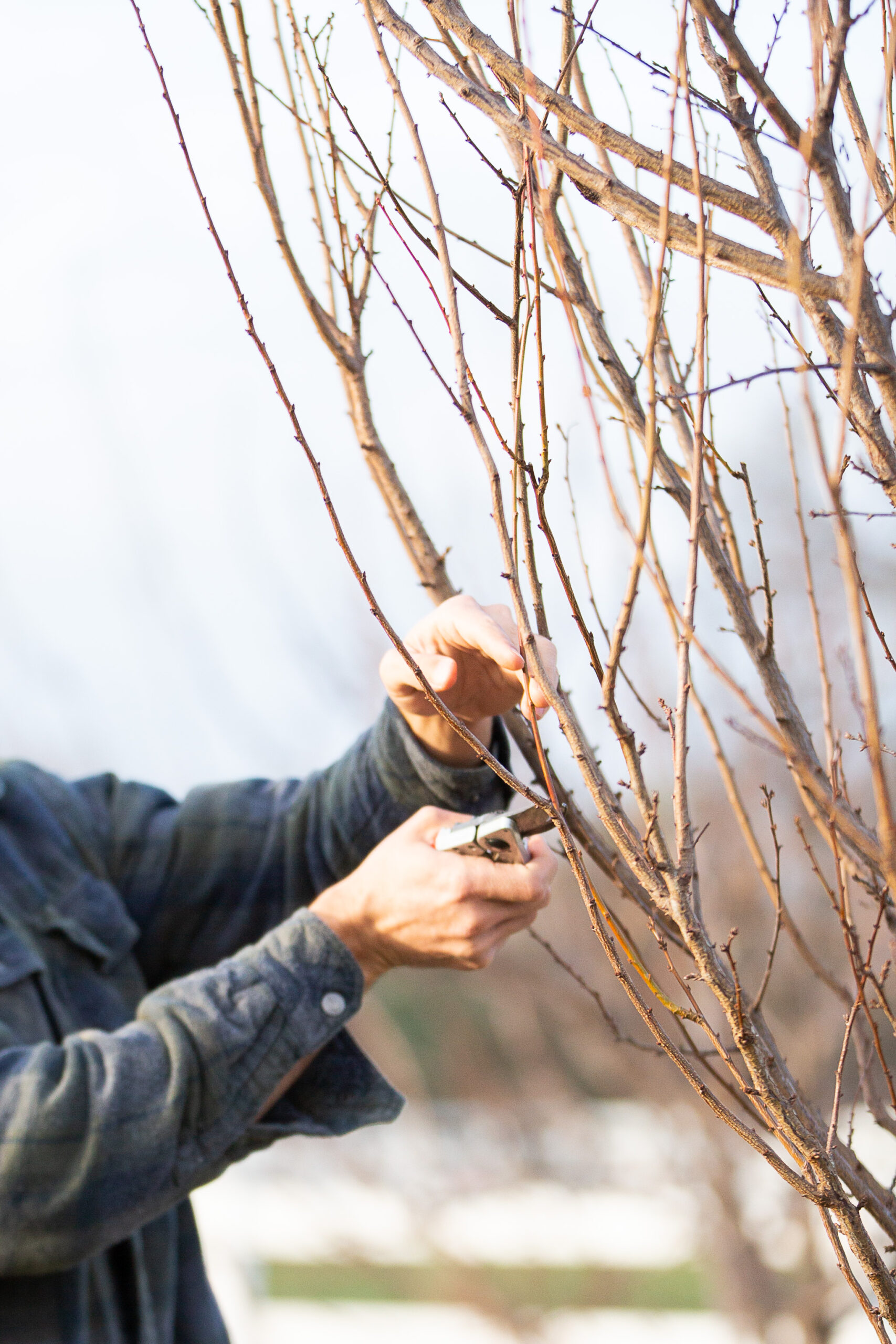
Tips for pruning fruit trees
- Do not remove any more than 1/3 of the tree in one given year.
- When you make a cut, make sure to cut the branch off right at the collar (part that swells as the branch grows) for a flush cut. This will allow the tree to heal the wound.
- Make sure to not leave a stub after cutting, because this will cause die back and could introduce the tree to disease.
- If you are pruning multiple trees at once, sterilize your tools between trees. We spray the tools with lysol and let them dry. You could also use rubbing alcohol or bleach to disinfect. If you are pruning a diseased plant, disinfect between cuts.
- Sharp tools will make healthier cuts, dull tools can open up the tree to disease.
- Winter pruning makes it easier to see the skeletal structure of the tree, so it is easiest for beginners.
- The majority of your cuts will be to an outward facing bud. The direction the bud is facing is the direction the branch will grow.
- Remove any crossed, diseased, or broken branches.

When to Prune Fruit Trees
The most common time to prune the tree for maximum production is during the dormant season. This is when you can do the heaviest pruning. Summer or Spring is also a great time to prune, but it is best for touch-ups or lighter pruning if the tree needs it. Keep in mind that not pruning at all is an option if you don’t mind the tree taking its natural form, it will be less productive this way. To get the most bang for you buck prune 1-2 times a year, at least!
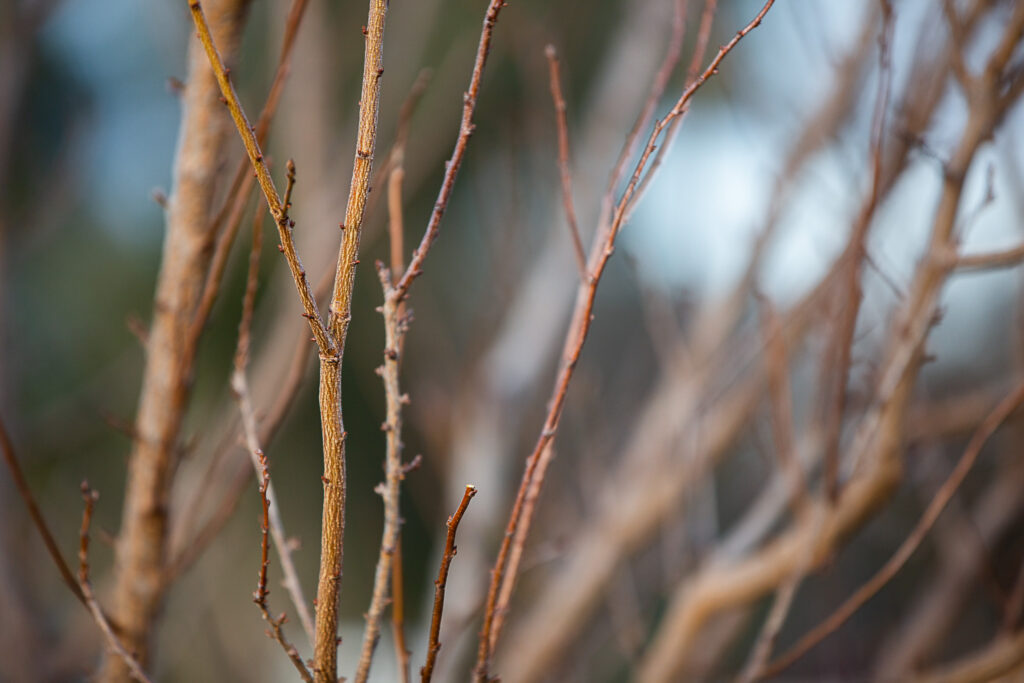
Pruning Fruit Trees in the Winter
Dormant season pruning, or very early spring, means that the tree’s buds have not started to swell. Pruning the tree during it’s dormant state will force more growth during it’s active season in the Spring. During the winter months, while the tree is still dormant, it can handle heavier pruning. Which is why it is the most important time to prune during the year.

Pruning Fruit Trees in the Spring
Pruning trees in the spring is possible, if the buds are already swollen it isn’t ideal. We typically pay attention to the fruit being set during spring. Spring is a great time to thin out any fruit so that the tree doesn’t become too over loaded with fruit. Thinning fruit will make for better quality of fruit set.
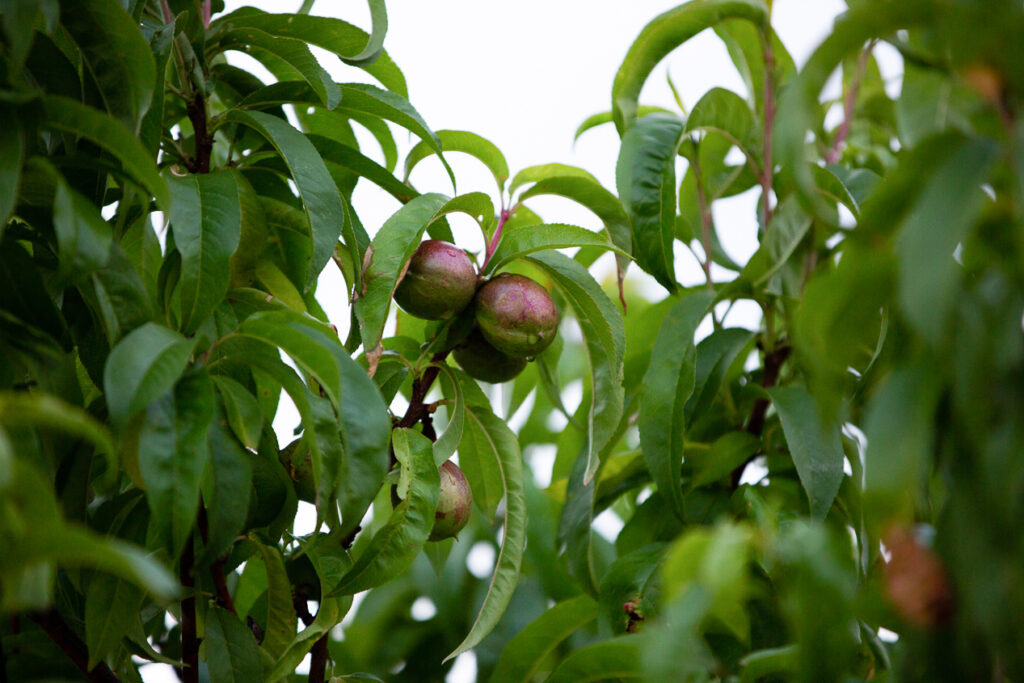
Pruning Fruit Trees in the Summer
Summer pruning is mainly control the lateral growth which can come for height management. The goal in Summer is to shape the tree by thinning out unnecessary branches if the tree is overly dense and to keep even symmetry. It is also shape the tree and manage the height. If you’ve missed some deadwood that is not producing any new growth, cut it out.

Pruning Fruit Trees in the Fall
We don’t typically prune in the Fall. Fall is a good time to get a head start on pruning as long as the tree is fully dormant. If you’ve got a large home orchard, like us, it is nice to get a head start and spread the job of pruning throughout the year, instead of waiting for all of it to be done in winter.
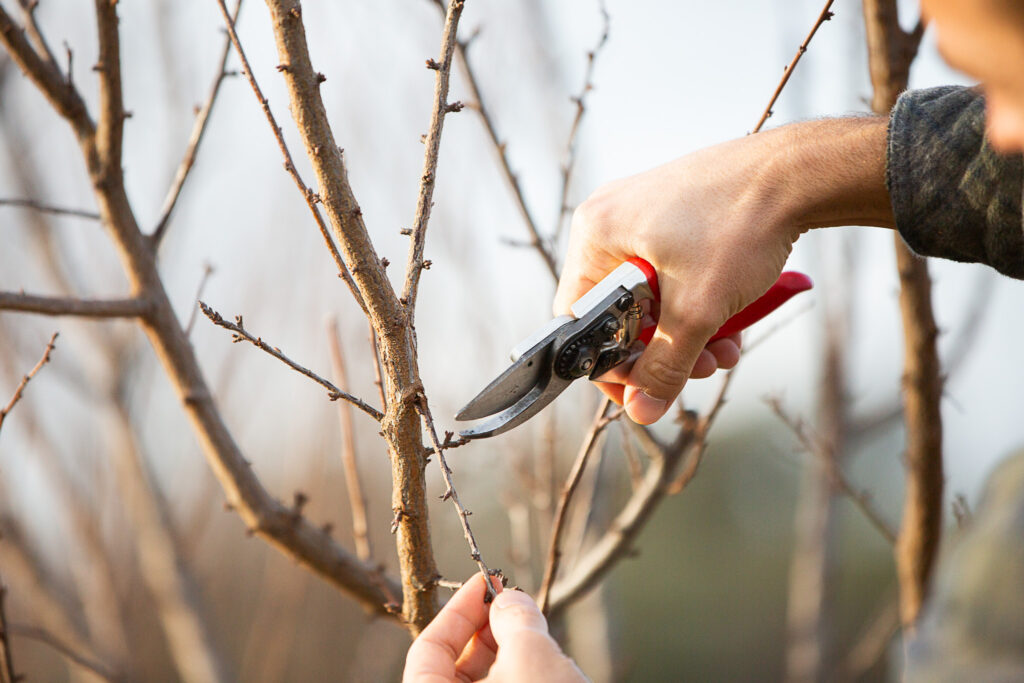
What should a properly pruned fruit tree look like?
Learning to prune a tree is much like it’s own art form. Each time you prune a tree, you’ll want to consider the existing skeletal structure of the tree to determine what that individual tree will need. There are two main types of tree structures that you can consider.
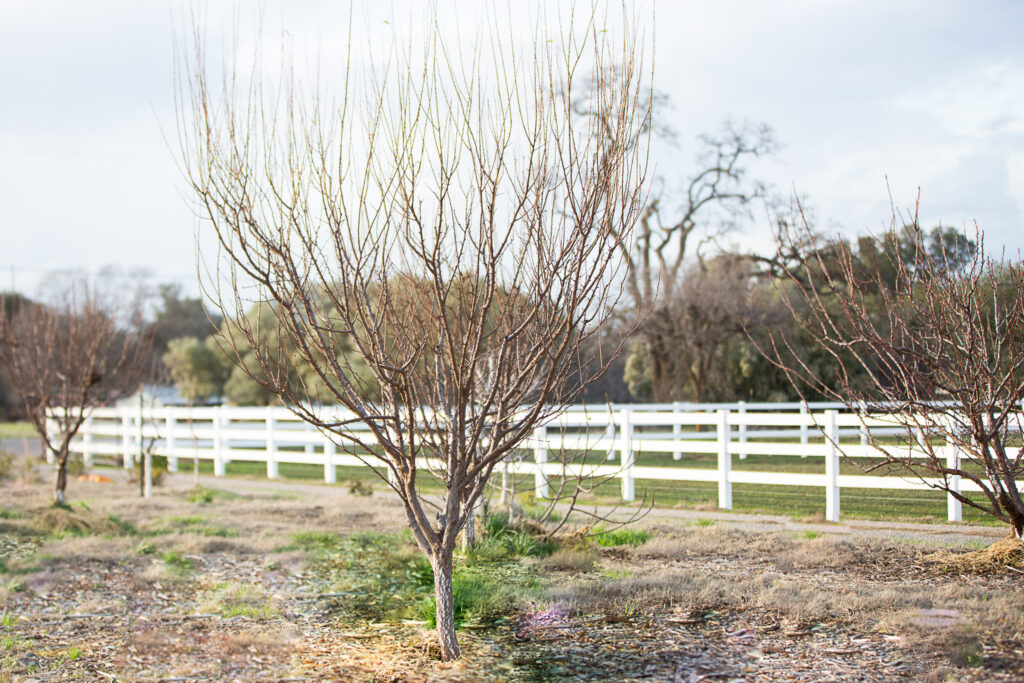
Open vase shape
- 3-5 main branches that come from the main trunk.
- Other branches will come off these 3-5 main branches to form the shape of the tree.
- The center of the tree “trunk” is pruned out, so the tree is open to the center (this will allow for more air and light)
- No branches growing to the center of the tree, this will make the tree difficult to tend, and harvest.
- Cut off any shoots that grow from the trunk
Central leader (modified central leader)
- 3-5 main branches that come from the main trunk.
- Other branches will come off these 3-5 main branches to form the shape of the tree.
- The center of the tree “trunk” is left, so the tree has a more classic form. Certain fruit trees benefit from this.
- No branches growing to the center of the tree, this will make the tree difficult to tend, and harvest.
- Cut off any shoots that grow from the trunk

Pruning a diseased tree
If you’ve got a tree that is diseased, you’ll have to first determine if the tree is salvageable. If the tree can survive a heavy pruning, follow the above steps to prune back the tree. EXCEPT you will want to burn the diseased wood to keep if from spreading to your other plants. Be sure to sterilize the tool you use on the diseased tree.

Fruit Tree Pruning After the First Year
Pruning a tree the is less than three years old is a bit different that an older tree. Pruning a young tree is the best time since you have more flexibility with increasing its structure, strength, promote fruiting branches, and almost eliminate crossing branches. After the tree has put on some growth from the initial cuts before planting, evaluate what is there. Once the new growth is about 3-4 inches, select the main skeletal structure of the tree (go back to the section about (central leader, or open base shape trees). Select your main branches and remove all other branches below it.
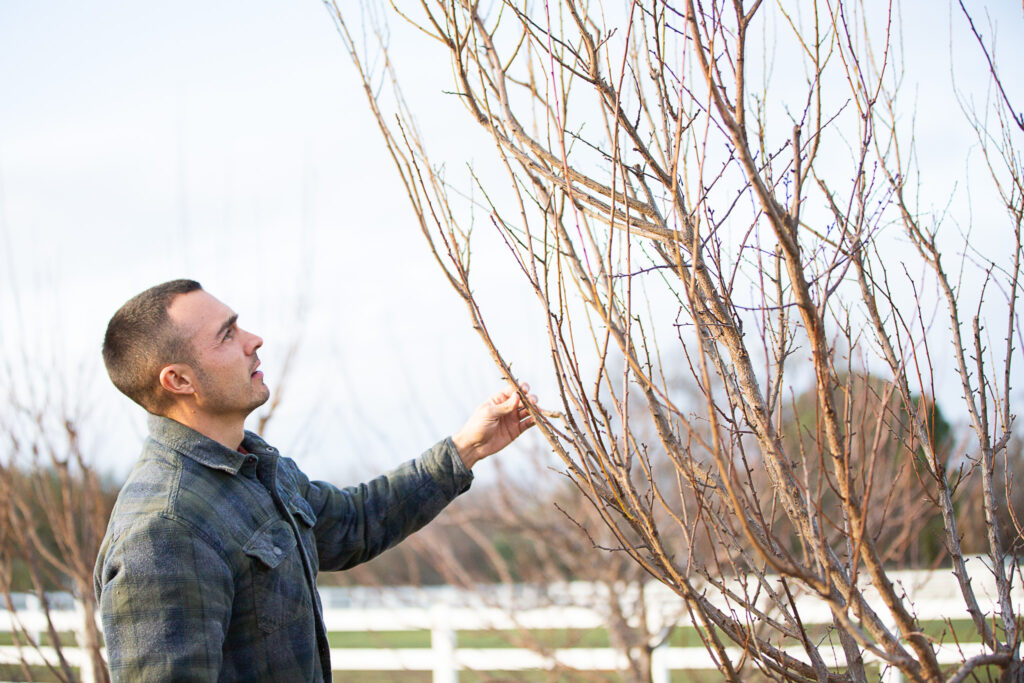
How to Prune a Fruit Tree After Three Years
The first three years should really about developing a good structure to the tree, taking away any cross branches, suckers, or inward growing branches. Now that the tree is older, you’ll want to continue working on this shape, and forcing side branches. Start pruning int he dormant season cutting away dead wood. You’ll want to make slightly angled cuts to avoid the water getting into the cuts. Keep the tree from becoming crowded, which will decrease fruit production.
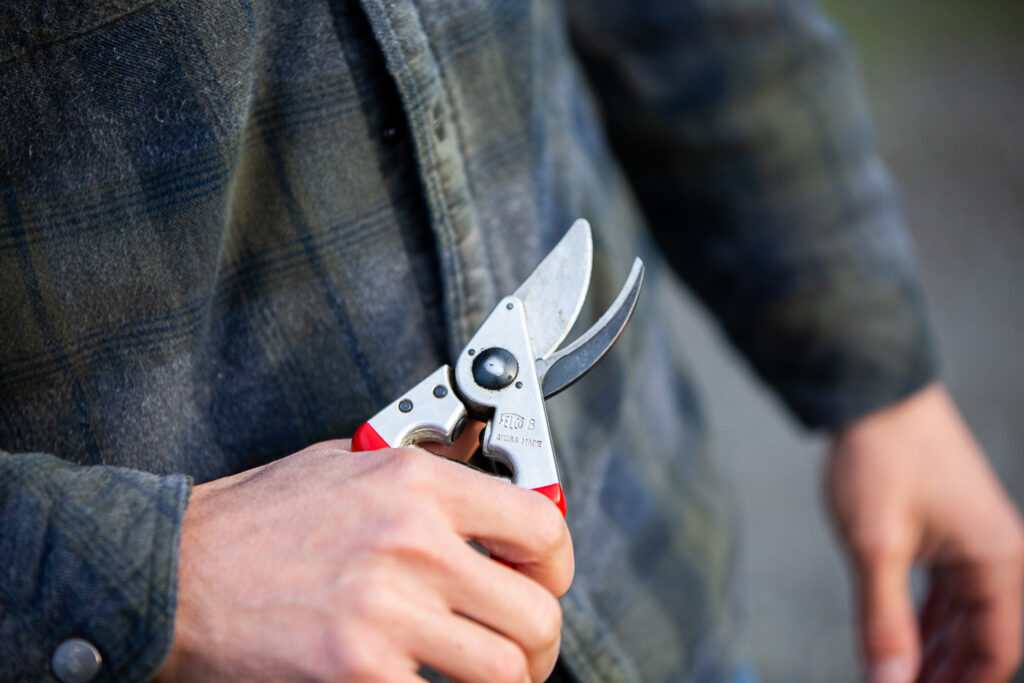
More Resources:
If you want an even more in depth explanation, we highly encourage you to read How to Prune Fruit Trees by R. Sanford Martin. This book will teach you everything you need to know about establishing and maintaining a wonderful home orchard!

You may also like:
Ideas for What to Have on a Homestead: Homestead Planning
How to Be More Self Sufficient
Pin if for later!


Leave a Reply